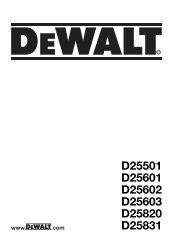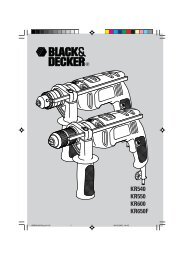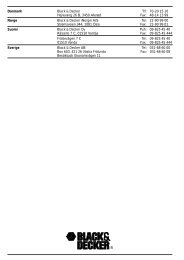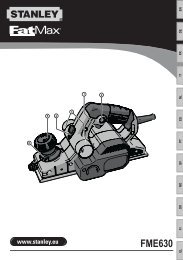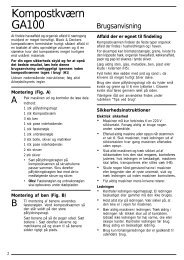DW754.PM5 14-03-2001, 15:22 1 - Service
DW754.PM5 14-03-2001, 15:22 1 - Service
DW754.PM5 14-03-2001, 15:22 1 - Service
Create successful ePaper yourself
Turn your PDF publications into a flip-book with our unique Google optimized e-Paper software.
Safety instructions<br />
When using stationary power tools,<br />
always observe the safety regulations applicable<br />
in your country to reduce the risk of fire, electric<br />
shock and personal injury. Read all of this<br />
manual carefully before operating the tool.<br />
Save this manual for future reference.<br />
General<br />
1 Keep work area clean<br />
Cluttered areas and benches can cause accidents.<br />
2 Consider work area environment<br />
Do not expose the tool to rain. Do not use the tool<br />
in damp or wet conditions. Keep the work area<br />
well lit (250 - 300 Lux). Do not use the tool where<br />
there is a risk of causing fire or explosion, e.g. in<br />
the presence of flammable liquids and gases.<br />
3 Keep children away<br />
Do not allow children, visitors or animals to come<br />
near the work area or to touch the tool or the<br />
mains cable.<br />
4 Dress properly<br />
Do not wear loose clothing or jewellery, as these<br />
can be caught in moving parts. Wear protective<br />
hair covering to keep long hair out of the way.<br />
When working outdoors, preferably wear suitable<br />
gloves and non-slip footwear.<br />
5 Personal protection<br />
Always use safety glasses. Use a face or dust<br />
mask whenever the operations may produce<br />
dust or flying particles. If these particles might be<br />
considerably hot, also wear a heat-resistant<br />
apron. Wear ear protection whenever the sound<br />
level seems uncomfortable, i.e. if the sound<br />
pressure stated in this manual exceeds 85 dB(A).<br />
6 Guard against electric shock<br />
Prevent body contact with earthed or surfaces<br />
(e.g. pipes, radiators, cookers and refrigerators).<br />
When using the tool under extreme conditions<br />
(e.g. high humidity, when metal swarf is being<br />
produced, etc.), electric safety can be improved<br />
by inserting an isolating transformer or a (FI)<br />
earth-leakage circuit-breaker.<br />
7 Do not overreach<br />
Keep proper footing and balance at all times.<br />
8 Stay alert<br />
Watch what you are doing. Use common sense.<br />
Do not operate the tool when you are tired.<br />
ENGLISH<br />
9 Secure workpiece<br />
Use clamps or a vice to hold the workpiece. It is<br />
safer and it frees both hands to operate the tool.<br />
10 Connect dust extraction equipment<br />
If devices are provided for the connection of dust<br />
extraction and collection facilities, ensure that<br />
these are connected and properly used.<br />
11 Remove adjusting keys and wrenches<br />
Always check that adjusting keys and wrenches are<br />
removed from the tool before operating the tool.<br />
12 Extension cables<br />
Before use, inspect the extension cable and<br />
replace if damaged. When using the tool<br />
outdoors, only use extension cables intended for<br />
outdoor use and marked accordingly.<br />
13 Use appropriate tool<br />
The intended use is described in this instruction<br />
manual. Do not force small tools or attachments<br />
to do the job of a heavy-duty tool. The tool will<br />
do the job better and safer at the rate for which it<br />
was intended. Do not force the tool.<br />
Warning! The use of any accessory or<br />
attachment or performance of any operation with<br />
this tool other than those recommended in this<br />
instruction manual may present a risk of personal<br />
injury.<br />
<strong>14</strong> Check for damaged parts<br />
Before use, carefully check the tool and mains<br />
cable for damage. Check for misalignment and<br />
seizure of moving parts, breakage of parts,<br />
damage to guards and switches and any other<br />
conditions that may affect its operation. Ensure<br />
that the tool will operate properly and perform its<br />
intended function.<br />
Do not use the tool if any part is damaged or<br />
defective. Do not use the tool if the switch does<br />
not turn it on and off. Have any damaged or<br />
defective parts replaced by an authorised<br />
DEWALT repair agent. Never attempt any repairs<br />
yourself.<br />
<strong>15</strong> Unplug tool<br />
Switch off and wait for the tool to come to a<br />
complete standstill before leaving it unattended.<br />
Unplug the tool when not in use, before changing<br />
any parts of the tools, accessories or<br />
attachments and before servicing.<br />
16 Avoid unintentional starting<br />
Be sure that the tool is switched off before<br />
plugging in.<br />
<strong>15</strong> en - 2<br />
<strong>DW754.PM5</strong> 23<br />
<strong>14</strong>-<strong>03</strong>-<strong>2001</strong>, <strong>15</strong>:23






